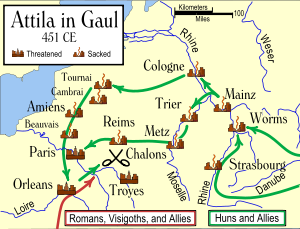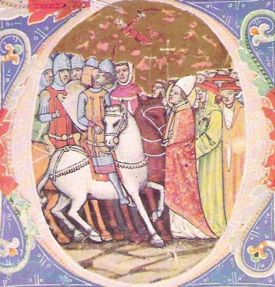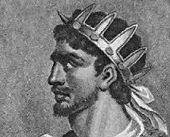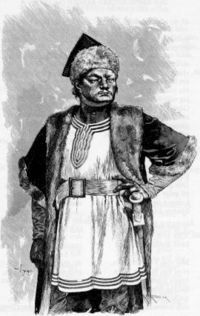Attila the Hun
2008/9 Schools Wikipedia Selection. Related subjects: Historical figures; Military People
| Attila the Hun | |
| (King of the Huns), as seen in Chronicon Pictum | |
 |
|
| Reign | 434– 453 |
|---|---|
| Born | 406 |
| Died | 453 |
| Predecessor | Bleda & Rugila |
| Successor | Ellac |
| Father | Mundzuk |
Attila ( 406 – 453), also known as Attila the Hun or the Scourge of God, was leader of the Huns from 434 until his death. He was leader of the Hunnic Empire which stretched from Germany to the Ural River and from the River Danube to the Baltic Sea (see map below). During his rule he was one of the most fearsome of the Western and Eastern Roman Empires' enemies: he invaded the Balkans twice, he marched through Gaul (modern France) as far as Orleans before being defeated at the Battle of Chalons. He refrained from attacking either Constantinople or Rome.
In much of Western Europe, he is remembered as the epitome of cruelty and rapacity. In contrast, some histories and Chronicles lionize him as a great and noble king, and he plays major roles in three Norse sagas.
Background
The origin of the Huns has been the subject of debate for centuries; however it can be said with general agreement that they were a confederation of Central Asian and European tribes, many of them horse nomads. Many experts think they were Turkic people, descended from the Xiongnu tribes that menaced China as early as the 5th century BC. The first emperor of China, Qin Shi Huangdi, built part of the Great Wall to keep the Xiongnu out.
Their united power appeared or began to form in Europe in the 400s. They achieved military superiority over their neighbours by their readiness for battle, unusual mobility, and weapons, including the composite bow.
Shared kingship

The death of Rugila (also known as Rua or Ruga) in 434 left his nephews Attila Dragomer and Bleda (also known as Buda), the sons of his brother Mundzuk, in control over all the united Hun tribes. At the time of their accession, the Huns were bargaining with Byzantine emperor Theodosius II's envoys over the return of several renegades (possibly Hunnic nobles not in agreement with the brothers' leadership) who had taken refuge within the Byzantine Empire. The following year Attila and Bleda met with the imperial legation at Margus (present-day Požarevac) and, all seated on horseback in the Hunnic manner, negotiated a successful treaty: the Romans agreed not only to return the fugitives, but also to double their previous tribute of 350 Roman pounds (ca. 114.5 kg) of gold, open their markets to Hunnish traders, and pay a ransom of eight solidi for each Roman taken prisoner by the Huns. The Huns, satisfied with the treaty, decamped from the empire and returned to their home in the Hungarian Great Plain, perhaps to consolidate and strengthen their empire. Theodosius used this opportunity to strengthen the walls of Constantinople, building the city's first sea wall, and to build up his border defences along the Danube.
Huns remained out of Roman sight for the next few years as a Hunnic force invaded the Persian Empire. A defeat in Armenia by the Sassanid Persians caused them to abandon this attempt and return their attentions to Europe. In 440 they reappeared in force on the borders of the Roman Empire, attacking the merchants at the market on the north bank of the Danube that had been established by the treaty. Crossing the Danube they laid waste to Illyrian cities and forts on the river, among them, according to Priscus, Viminacium, which was a city of the Moesians in Illyria. Their advance began at Margus, for when the Romans discussed handing over the offending bishop, he slipped away secretly to the Huns and betrayed the city to them.
As Theodosius had conquered the river's defences, the Vandals, under the leadership of Geiseric, captured the Western Roman province of Africa with its capital of Carthage in 440 and the Sassanid Yazdegerd II invaded Armenia in 441. Stripping the Balkan defenses of forces requested by the West Romans, in order to launch an attack on the Vandals in Africa (which was the richest province of the Western empire and a main source of the food supply of Rome, left Attila and Bleda a clear path through Illyria into the Balkans, which they invaded in 441. The Hunnish army, having sacked Margus and Viminacium, took Singidunum (modern Belgrade) and Sirmium before halting. A lull followed in 442 and during this time Theodosius recalled his troops from Sicily and ordered a large new issue of coins to finance operations against the Huns. Having made these preparations, he thought it safe to refuse the Hunnish kings' demands.
Attila responded by their campaign in 443. Striking along the Danube, they overran the military centres of Ratiara and successfully besieged Naissus (modern Niš) with battering rams and rolling towers — military sophistication that was new to the Hun repertoire — then pushing along the Nisava they took Serdica ( Sofia), Philippopolis ( Plovdiv), and Arcadiopolis. They encountered and destroyed the Roman army outside Constantinople and were stopped by the double walls of the Eastern capital. A second army was defeated near Callipolis (modern Gallipoli) and Theodosius, now without any armed forces to respond, admitting defeat, sent the court official Anatolius to negotiate peace terms, which were harsher than the previous treaty: the Emperor agreed to hand over 6,000 Roman pounds (ca. 1,963 kg) of gold as punishment for having disobeyed the terms of the treaty during the invasion; the yearly tribute was tripled, rising to 2,100 Roman pounds (ca. 687 kg) in gold; and the ransom for each Roman prisoner rose to 12 solidi.
Their demands met for a time, the Hun kings withdrew into the interior of their empire. According to Jordanes (following Priscus), sometime during the peace following the Huns' withdrawal from Byzantium (probably around 445), Bleda died (killed by his brother, according to the classical sources), and Attila took the throne for himself.
Sole ruler
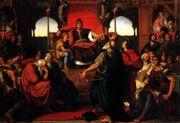
"When evening began to draw in, torches were lighted, and two barbarians came forward in front of Attila and sang songs which they had composed, hymning his victories and his great deeds in war. And the banqueters gazed at them, and some were rejoiced at the songs, others became excited at heart when they remembered the wars, but others broke into tears—those whose bodies were weakened by time and whose spirit was compelled to be at rest.
In 447 Attila again rode south into the empire through Moesia. The Roman army under the Gothic magister militum Arnegisclus met him in the Battle of the Utus and was defeated, though not without inflicting heavy losses. The Huns were left unopposed and rampaged through the Balkans as far as Thermopylae. Constantinople itself was saved by the intervention of the prefect Flavius Constantinus who organized the reconstruction of the walls that had been previously damaged by earthquakes, and, in some places, to construct a new line of fortification in front of the old. An account of this invasion survives:
- The barbarian nation of the Huns, which was in Thrace, became so great that more than a hundred cities were captured and Constantinople almost came into danger and most men fled from it. … And there were so many murders and blood-lettings that the dead could not be numbered. Ay, for they took captive the churches and monasteries and slew the monks and maidens in great numbers.
- — Callinicus, in his Life of Saint Hypatius
Attila in the west
In 450 Attila had proclaimed his intent to attack the powerful Visigoth kingdom of Toulouse, making an alliance with Emperor Valentinian III in order to do so. He had previously been on good terms with the Western Roman Empire and its de facto ruler Flavius Aëtius. Aëtius had spent a brief exile among the Huns in 433, and the troops Attila provided against the Goths and Bagaudae had helped earn him the largely honorary title of magister militum in the west. The gifts and diplomatic efforts of Geiseric, who opposed and feared the Visigoths, may also have influenced Attila's plans.
However Valentinian's sister was Honoria, who, in order to escape her forced betrothal to a Roman senator, had sent the Hunnish king a plea for help — and her engagement ring — in the spring of 450. Though Honoria may not have intended a proposal of marriage, Attila chose to interpret her message as such. He accepted, asking for half of the western Empire as dowry. When Valentinian discovered the plan, only the influence of his mother Galla Placidia convinced him to exile, rather than kill, Honoria. He also wrote to Attila strenuously denying the legitimacy of the supposed marriage proposal. Attila, not convinced, sent an emissary to Ravenna to proclaim that Honoria was innocent, that the proposal had been legitimate, and that he would come to claim what was rightfully his.
Attila also interfered in a succession struggle after the death of a Frankish ruler. Attila supported the elder son, while Aëtius supported the younger.
Attila gathered his vassals— Gepids, Ostrogoths, Rugians, Scirians, Heruls, Thuringians, Alans, Burgundians, among others and began his march west. In 451 he arrived in Belgica with an army exaggerated by Jordanes to half a million strong. J.B. Bury believes that Attila's intent, by the time he marched west, was to extend his kingdom — already the strongest on the continent — across Gaul to the Atlantic Ocean.
On April 7, he captured Metz. Other cities attacked can be determined by the hagiographic vitae written to commemorate their bishops: Nicasius was slaughtered before the altar of his church in Rheims; Servatus is alleged to have saved Tongeren with his prayers, as Saint Genevieve is to have saved Paris. Lupus, bishop of Troyes, is also credited with saving his city by meeting Attila in person.
Aëtius moved to oppose Attila, gathering troops from among the Franks, the Burgundians, and the Celts. A mission by Avitus, and Attila's continued westward advance, convinced the Visigoth king Theodoric I (Theodorid) to ally with the Romans. The combined armies reached Orleans ahead of Attila, thus checking and turning back the Hunnish advance. Aëtius gave chase and caught the Huns at a place usually assumed to be near Catalaunum (modern Châlons-en-Champagne). The two armies clashed in the Battle of Chalons, whose outcome is commonly considered to be a Pyrrhic victory for the Visigothic-Roman alliance. Theodoric was killed in the fighting and Aëtius failed to press his advantage, according to Edward Gibbon and Edward Creasy because he feared the consequences of an overwhelming Visogothic triumph as much as he did a defeat. From Aëtius' point of view, the best outcome was what occurred: Theodoric died, Attila was in retreat and disarray, and the Romans had the benefit of appearing victorious.
Invasion of Italy and death
Attila returned in 452 to claim his marriage to Honoria anew, invading and ravaging Italy along the way. The city of Venice was founded as a result of these attacks when the residents fled to small islands in the Venetian Lagoon. His army sacked numerous cities and razed Aquileia completely, leaving no trace of it behind. Legend has it he built a castle on top of a hill north of Aquileia to watch the city burn, thus founding the town of Udine, where the castle can still be found. Aëtius, who lacked the strength to offer battle, managed to harass and slow Attila's advance with only a shadow force. Attila finally halted at the River Po. By this point disease may have broken out in Attila's camp, thus helping to stop his invasion.
At the wish of Emperor Valentinian III, Pope Leo I, accompanied by the Consul Avienus and the Prefect Trigetius, met Attila at Mincio in the vicinity of Mantua, and obtained from him the promise that he would withdraw from Italy and negotiate peace with the emperor. Prosper of Aquitaine gives a short, reliable description of the historic meeting. The later anonymous account, a pious "fable which has been represented by the pencil of Raphael and the chisel of Algardi" (as Gibbon called it) says that the Pope, aided by Saint Peter and Saint Paul, convinced him to turn away from the city, promising Attila that in case he leaves in peace, one of his successor will receive a Holy Crown. Priscus reports that superstitious fear of the fate of Alaric—who died shortly after sacking Rome in 410—gave him pause.
After Attila left Italy and returned to his palace across the Danube, he planned to strike at Constantinople again and reclaim the tribute which Marcian had cut off. (Marcian was the successor of Theodosius and had ceased paying tribute in late 450 while Attila was occupied in the west; multiple invasions by the Huns and others had left the Balkans with little to plunder.) However Attila died in the early months of 453. The conventional account, from Priscus, says that at a feast celebrating his latest marriage to the beautiful and young Ildico (if uncorrupted, the name suggests a Gothic origin) he suffered a severe nosebleed and choked to death in a stupor. An alternative theory is that he succumbed to internal bleeding after heavy drinking or a condition called esophageal varices, where a hemorrhoid in the lower part of the esophagus ruptures leaving the person to choke on his/her own blood.
Another account of his death, first recorded 80 years after the events by the Roman chronicler Count Marcellinus, reports that "Attila, King of the Huns and ravager of the provinces of Europe, was pierced by the hand and blade of his wife." The Volsunga saga and the Poetic Edda also claim that King Atli (Attila) died at the hands of his wife, Gudrun. Most scholars reject these accounts as no more than hear-say, preferring instead the account given by Attila's contemporary Priscus. Priscus' version, however, has recently come under renewed scrutiny by Michael A. Babcock. Based on detailed philological analysis, Babcock concludes that the account of natural death, given by Priscus, was an ecclesiastical "cover story" and that Emperor Marcian (who ruled the Eastern Roman Empire from 450-457) was the political force behind Attila's death.
Jordanes says, "the greatest of all warriors should be mourned with no feminine lamentations and with no tears, but with the blood of men." His horsemen galloped in circles around the silken tent where Attila lay in state, singing in his dirge, according to Cassiodorus and Jordanes, "Who can rate this as death, when none believes it calls for vengeance?" then celebrated a strava (lamentation) over his burial place with great feasting. Legend says that he was laid to rest in a triple coffin made of gold, silver, and iron, along with some of the spoils of his conquests. His men diverted a section of the river Tisza, buried the coffin under the riverbed, and then were killed to keep the exact location a secret.
His sons Ellac (his appointed successor), Dengizich, and Ernakh fought over the division of his legacy, specifically which vassal kings would belong to which brother. As a consequence they were divided, defeated and scattered the following year in the Battle of Nedao by the Ostrogoths and the Gepids under Ardaric. According to Jordanes, Ardaric, who was once Attila's most prized chieftain, turned against the feuding brothers when he felt that they were treating the nations they ruled as slaves.
Attila's many children and relatives are known by name and some even by deeds, but soon valid genealogical sources all but dry up and there seems to be no verifiable way to trace Attila's descendants. This hasn't stopped many genealogists from attempting to reconstruct a valid line of descent for various medieval rulers. One of the most credible claims has been that of the tsars of Bulgaria (see Nominalia of the Bulgarian khans). A popular, but ultimately unconfirmed attempt tries to relate Attila to Charlemagne (see Attila the Hun to Charlemagne).
Appearance, character, and name
There is no surviving first-person account of Attila's appearance. There is, however, a possible second hand source, provided by Jordanes, who claimed Priscus described Attila as:
short of stature, with a broad chest and a large head; his eyes were small, his beard thin and sprinkled with grey; and he had a flat nose and tanned skin, showing evidence of his origin.
Attila is known in Western history and tradition as the grim flagellum dei (Latin: "Scourge of God"), and his name has become a byword for cruelty and barbarism. Some of this may have arisen from confusion between him and later steppe warlords such as Genghis Khan and Tamerlane. All are considered to be cruel, clever, and blood-thirsty lovers of battle and pillage. The reality of his character is probably more complex. The Huns of Attila's era had been mingling with Roman civilisation for some time, largely through the Germanic foederati of the border, so that by the time of Theodosius's embassy in 448 Priscus could identify two primary languages among the Huns, Gothic and Hunnic, with some people knowing Latin and Greek. Priscus also recounts his meeting with an eastern Roman captive who had so fully assimilated into the Huns' way of life that he had no desire to return to his former country, and the Byzantine historian's description of Attila's humility and simplicity is unambiguous in its admiration.
According to Jacques Le Goff, the women of Attila's time were fascinated by him and often fantasised about him, thus Attila became something of a 5th century "sex symbol."
The origin of Attila's name is not known with confidence, because very little is known about Hunnic names. In the Hunnic language Danube-Bulgarian, the etymology "oceanic (universal) [ruler]" has been proposed. Also the word possibly originates from Turkic Atyl/Atal/Atil meaning water, river (also, ancient name of Volga river) with adjective suffix -ly. (Compare also Turkic medieval notable title atalyk - "senior as father"). This is correlating to the fact that the Polish Chronicle is using Attila's name as Aquila bearing the Latin aqua inside. Others believe that the name may have connection to Hungarian Ítélet meaning judgement or Gothic (or Gepid) atta ("father") and the diminutive suffix -ila. Attila was not a rare name in Central Europe prior to Attila making his mark on history; the historical record shows numerous persons with the name preceding him. 'Attila' has many variants: Atli and Atle in Norse, Ætla, Attle and Atlee in English, Attila/Atilla/Etele in Hungarian (all the three name variants are used in Hungary; Attila is the most popular variant), Etzel in modern German or Attila, Atila or Atilla in modern Turkish.
Fictional representations
Attila has been portrayed in various ways, sometimes as a noble ruler, sometimes as a cruel barbarian.
- In the German epic Nibelungenlied Etzel is portrayed as a noble and generous ally, while Atli in the Volsunga Saga and the Poetic Edda (and Ætla in Widsith) is a cruel miser.
- In The Divine Comedy, Attila appears in the seventh circle of Hell, immersed in a river of boiling blood, and is called "the scourge of Earth". Dante also charges him with the destruction of Florence, but this is a blunder by the author, who has confused him with the Ostrogothic warlord Totila.
- Giuseppe Verdi made him the title character of an opera.
- Hungarian Géza Gárdonyi's novel A láthatatlan ember (1901) (published in English as Slave of the Huns and largely based on Priscus) offered a sympathetic portrait of Attila as a wise and beloved leader. This reflects the positive way in which Attila, his last wife Ildikó and his brother Bleda are viewed in Hungary and Turkey.
- The novel The White Stag, the Newbery Medal winning book of 1938, is a retelling of the legend of the rise of Attila the Hun written in lyric prose.
- Thomas Costain's The Darkness and Dawn (1959) is written from the point of view of Nicolan, carried into slavery from his home on the Danube and after many adventures becoming Attila's aide - but also becoming romantically involved with the beautiful Ildico, which is quite dangerous.
- The Death of Attila by Cecelia Holland (1973) takes place in 453, with the tensions and uncertainty of Attila's last year being the background for an unlikely friendship between Tacs, a young, ne'er-do-well Hunnish warrior, and Dietric, son of a Germanic subject king.
- The British writer Anthony Burgess wrote a biographical novella about Attila entitled Hun which was published in the story collection The Devil's Mode (1989).
- Anthony Quinn played the role of Attila in a film co-starring Sophia Loren as Honoria.
- Attila was portrayed by Jack Palance in Douglas Sirk's Sign of the Pagan (1954).
- A TV miniseries, Attila, which was produced in 2000 and was broadcast in 2001 stars Gerard Butler as Attila and Powers Boothe as Flavius Aëtius.
- He is a powerful and charismatic figure in Bill Napier's ongoing trilogy, Attila (volume one published in 2005, see ).
- The black metal band Dimmu Borgir made a song praising Attila called "Hunnerkongens Sorgsvarte Ferd Over Steppene", "The King of the Huns' Sorrowful Black Journey over the Steppes".
- Hungarian musician Levente Szörényi (from the band Illés), wrote a rock opera titled Attila, Isten kardja (Attila, Sword of God).
- The PC game Age of Empires II: The Conquerors Expansion has a single player campaign involving Attila's conquests.
- Hungarian poet János Arany wrote an epic poem about Attila and his brother Bleda called Buda halála (The Death of King Buda) which is part of a larger work titled A Csaba-trilógia (The Csaba Trilogy).
- A popular aphorism is to speak of extreme right-wing politicians or ultra- conservative businessmen as being To the right of Attila the Hun.
Comedic examples
Though not typically associated with light-heartedness, Attila (or his stereotype) has been invoked in a comedic way from time to time:
- Attila is the protagonist of the Italian comedy movie, Attila, flagello di Dio, directed by Castellano and Pipolo, and staring Diego Abatantuono. This 1982 film has become a cult classic, and is a prime example of Italian cinema trash of the 1980s. It is still very well known among Italy's younger generations.
- The comic strip character Broom-Hilda is supposedly Attila's ex-wife.
- Another comic strip, The Wizard of Id, features occasional invasions by The Huns.
- In Woody Allen's satirical film Love and Death, Diane Keaton's character justifies a plan to assassinate Napoleon based on this alleged quote by Attila: "Violence is justified in the service of mankind".
- In "Scrooged" starring Bill Murray, The Ghost of Christmas Past (David Johansen) makes reference to having visited Attila the Hun, who cried like "Niagra Falls" upon seeing his younger mother in vision.
- In Will Cuppy's satirical European history book, The Decline and Fall of Practically Everybody, he makes fun of the question of how to pronounce Attila's name: "Attila does not rhyme with vanilla as it used to in my day. It is believed that, if children can be taught to accent Attila on the first syllable, things may take a turn for the better."
- Episode 20 of Monty Python's Flying Circus is titled "The Attila the Hun Show", featuring Attila and his family as sitcom characters, as well as parody characters Attila the Nun and Attila the Bun.
- In Shawn Levy's children's film Night at the Museum, a wax mannequin of Attila at the Museum of Natural History, along with everything else in the museum, is brought to life on a nightly basis via an ancient Egyptian curse and acts as an enemy though eventually a friend to the protagonist; a museum night-watchman. He is incorrectly depicted in the film as being East Asian. His destructiveness as an adult is attributed to a heartbreaking experience he had as a child.
- In the movie The Return of the Pink Panther, the Chief Inspector Dreyfus ( Herbert Lom) quotes, "Compared to [Inspector] Clouseau ( Peter Sellers), Attila the Hun was a Red Cross volunteer."
- In an episode of the early 1960s sitcom The Dick Van Dyke Show, the character Rob Petrie belts out a ditty called "I'm In Love With Attila the Hun" which he co-wrote with an old army buddy. In a 1967 episode of That Girl titled "Author, Author", Ann's fiance, the character of Donald Hollinger, sings and claims credit to the exact same tune. The song was also used in an episode of Good Morning World.
- Margaret Thatcher was widely nicknamed 'Attila the Hen' when she was British Prime Minister
- Attila shared his name in a TMNT episode Invasion Of The Punk Frogs with one of the frogs Shredder found and trained. He carries a flail.
Literature
- Babcock, Michael A. ( 2005) The Night Attila Died: Solving the Murder of Attila the Hun (Berkley Publishing Group, ISBN 0-425-20272-0)
- Blockley, R.C. (1983) The Fragmentary Classicising Historians of the Later Roman Empire, vol. II ( ISBN 0-905205-15-4). This is a collection of fragments from Priscus, Olympiodorus, and others, with original text and translation.
- Gordon, C. D. (1960) The Age of Attila: Fifth-century Byzantium and the Barbarians (Ann Arbor, University of Michigan Press, ISBN 0472061119). This is a translated collection, with commentary and annotation, of ancient writings on the subject, including Priscus.
- Heather, Peter ( 2005) The Fall of the Roman Empire—A New History of Rome and the Barbarians (Oxford University Press, ISBN 0195159543)
- Howarth, Patrick (1994) Attila, King of the Huns: The Man and the Myth ( ISBN 0786709308).
- Maenchen-Helfen, J. Otto (1973) The World of the Huns: Studies in Their History and Culture (Berkeley, University of California Press, ISBN 0520015967)
- Man, John ( 2005) Attila: A Barbarian King and the Fall of Rome (Bantam Press, ISBN 0-593-05291-9)
- Thompson, E. A. (1948) A History of Attila and the Huns (London, Oxford University Press, ISBN 0837176409). This is the authoritative English work on the subject. It was reprinted in 1999 as The Huns in the Peoples of Europe series ( ISBN 0-631-21443-7). Thompson did not enter controversies over Hunnic origins and considers his victories to have been achieved only when there was no concerted opposition.
Historical Fiction based on Attila the Hun
- Napier, William, The Attila Trilogy:
- Attila (Orion Books Ltd, 2005) ISBN 0-7528-7787-9)
- The Gathering of the Storm (Orion Books Ltd, 2007) ISBN 978-0-75287-433-3)
- Date of publishing of the third book in the trilogy unknown.
| Preceded by Rugila |
Hunnic rulers jointly with Bleda 434 – 445 |
Succeeded by Ellac |
